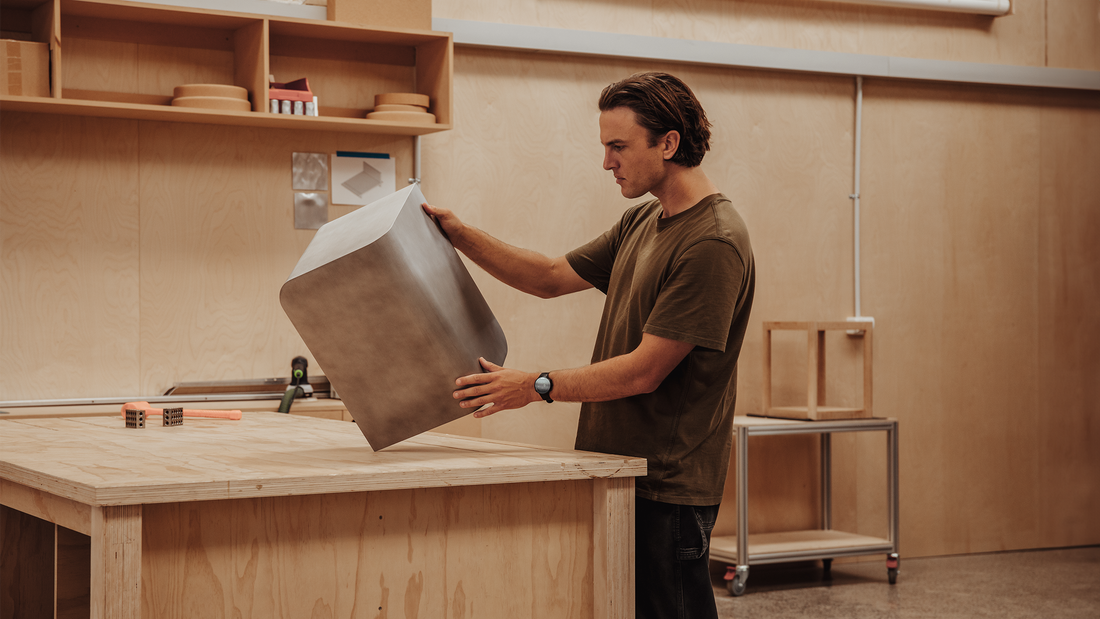Known for his mastery in woodworking, New Zealand designer Ted Synnott ventures into uncharted territory with the Volume Side Table, a seamless fusion of natural forms and industrial sleekness.
For Ted Synnott, the path to becoming a furniture designer was shaped by an array of influences. Born and raised on a farm in New Zealand, a love for creativity found its roots early on and his childhood years were characterised by a balance between athletic pursuits and creative endeavours, including painting with his aunt and making clothes with his mother.
It wasn't until later in life that he discovered that working with hands was a particular strength and enrolled to study traditional timber furniture-making as a tangible outlet for his burgeoning ideas and the development of his practical skills. His journey continued with employment at several furniture companies and culminated in the establishment of his eponymous studio in 2019, marking the beginning of his independent and distinctive approach to furniture design.
Without a formal design education, Ted’s knowledge is autonomous and largely shaped through online resources and books on the history and principles of design. A pivotal moment occurred during a visit to Europe in 2023 where he exhibited at the Stockholm Furniture Fair: the trip provided a complete sensory experience of the objects and spaces he had previously only abstracted through images.
For Ted, good design is “simple, functional and cost-effective to produce.” Although he acknowledges this as an ideal and notes “there is space and justification for things that focus more on beauty than pragmatism.”

His design process is meticulous and thoughtful, focusing on a simplicity of form, a sensitivity to detail and a quest to find something different in the familiar. “What I'm interested in continues to evolve but I really enjoy design that communicates clearly, regardless of the discipline. I like to think about the design process as looking in the same place as everyone else for something different,” he avers.
“I often labour over ideas for considerable time before finally bringing them to life. I’m always considering how things will be produced, which dictates the ideas I pursue. I enjoy exploring materials and manufacturing techniques to expand my possible output.”
While wood offers familiarity, warmth and tactility, Ted finds metals ”exacting, sanitary, easy to maintain and indifferent to most climatic conditions.” Most of his furniture is shaped from timber but he has been working increasingly with metals.
“Metals in general are well suited to industrial production as they are standardised, ubiquitous, uniform in appearance and typically require less post-processing work than organic materials. Aluminium has the added benefits of being infinitely recyclable—without loss of material of quality—as well being impervious to rust because it contains no iron,” he explains.

Loose sheet paper sketches transform into cohesive collections through a gradual amalgamation of details and concepts, resulting in a final product that often reflects his deep connection to traditional wood craftsmanship: “Because I have more experience in timber than paper or card, I tend to go straight to the end point, for better or for worse.”
And while wood holds a special place, Ted’s exploration of stone and metal adds diversity to his practice and he embraces the inherent qualities of each material, the latter most notably on the Volume Side Table.
Emerging from an encounter while drawing, the Volume Side Table is distinctly different when viewed from each of its four sides. Stumbling upon the form while drawing cubes as a pause to think of new ideas, Ted rounded some edges and realised that the shape tessellated in three dimensions. “This is a lot of what appeals about it to me, it's unintuitive and invites closer inspection. Universal familiarity with primary shapes makes the design broadly appealing, while its subtle deviation from expectation piques interest,” he notes.
“Timber has individual character and variation that are both good and bad when producing larger quantities. On one hand, it differentiates each unit of production through a unique grain pattern and tone. But these appealing differences also add complication at an industrial scale as idiosyncratic timber grain may require different processing than another. Wood movement, as it absorbs and releases moisture, and orientation also needs to be considered throughout the design process whereas metal changes size comparatively little in response to humidity or heat.”

As a series of tessellating planes, it was logical to Ted to make it from sheet metal and aluminium was chosen for its uniformity and workability. ”Once welded, ground and brushed, the uniform surface makes it appear as a homogenous whole, like stone or silver bullion rather than an object of multiple pieces. This cohesive appearance lends the table a feeling of permanence,” he adds.
Looking to the future, Ted believes the rise of AI tools will reshape the industry and the role of designers. “People will be overwhelmed by an abundance of AI-generated content in the digital realm and designers will need to work collaboratively with these tools, filtering the mass of information and deciding which ideas to develop from digital data into physical matter,” he notes, adding that while this shifting landscape will undoubtedly change our approach, “the physical world maintains immutable characteristics and constraints that all new ideas still need to abide by.”
